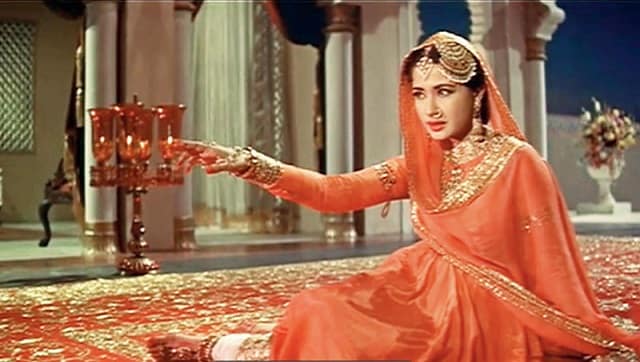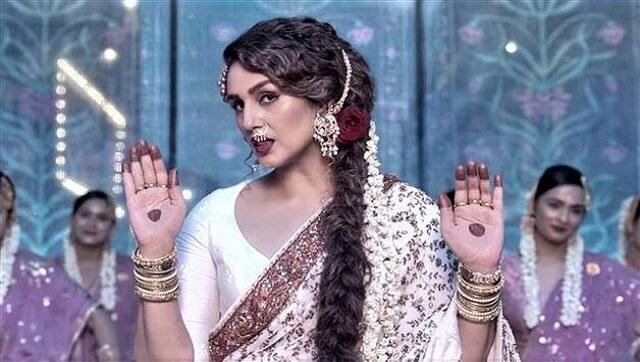Queer Gaze is a monthly column where Prathyush Parasuraman examines traces of queerness in cinema and streaming — intended or unintended, studied or unstudied, reckless or exciting. * In 2014, the British Film Institute [BFI] Flare London LGBT Film Festival screened both _Pakeezah _ and Mughal-e-Azam. At first, this might seem odd. But both films, unquestionably heterosexual in their narrative, have become deeply queer in their reception over time — with their songs being performed in drawing rooms, empty homes, drag parties, bath tubs, pride parades, and film festivals. Meena Kumari, the titular lead of Pakeezah, was spun into a queer icon, one who gestures at the subversive, at the erotic with “a quiet quiver of [her] lips or a heavily lifted eye”, one who, allegedly, told a man she spent a night with, “raat gayi baat gayi”. This queer reception can be broadly understood in two ways. One is the indulgence in spectacle, in camp — like Pakeezah breaking glass on the floor to then do the chakkars of Kathak at the wedding of her lover by stamping on the shards, bleeding crimson over white cloth on the floor in a trance, or Anarkali performing a lavish expression of love, multiplying herself in the shards of mirrors above, bleeding metaphorically in front of the disapproving father of her lover. The nakhra, the affectation, something considered frivolous, an embellishment, is now tied to the very centrality of being queer. The second is what this camp represents — an expression and an alchemical transformation of suffering by masking it in exaggerated overtures. The poet and founder of Dalit Panthers, Namdeo Dhasal, who lived a lane away from the red-light district of Kamathipura, waxes poetic about the plight of such characters, “This is pain wearing a dancer’s anklets.” [caption id=“attachment_10344381” align=“alignnone” width=“640”]  Meena Kumari in Pakeezah[/caption] But when looked at another way, as Vikram Phukan notes, these films helps paint “the gay man as [an] eternal victim,” constantly throwing one’s lot in the competition of despair. “Even self-pity needs cultural trappings,” Phukan writes. It is also true that a lot of these queer readings are retroactive, giving one’s present queerness a foundational text, an origin story, despairing at the vacuum of queers in history, and elbowing our way into its crowded dance floor. What also connects Mughal-e-Azam and Pakeezah is that both films tell the story of a courtesan who gets engulfed in a love considered beyond their station, a love that is consumptive and corrosive. That the courtesan figure, through these films, has found warmth and weft among the queers is not surprising. As Rahul Sen notes in his presentation Did Pakeezah Read Sappho? Or A Curious Case Of Queer Desire, both the courtesan and the queer betray normative expectations — of time, of family, of reproductive futurism, of flaunting vulnerability.
If you want to stretch this line of thought, perhaps to an uncomfortable snapping point, it can be argued that the courtesan is queer. It is this figure of the courtesan that _Gangubai Kathiawadi _ both continues and complicates.
Starring Alia Bhatt as the eponymous “mafia queen” of Kamathipura, the exaggerated overtures, the grace in the abrasive exchanges, the poetics in the violence, the melancholic shafts of light during a celebration are all here. Take ‘Dholida,’ a Navratri celebration song which comes right after Gangubai tries and fails to connect with her family who decide they want nothing to do with her. The song ends in her swirling in a trance, a 50-second shot that is disorienting and discomforting. But the central tension, unlike Pakeezah or Mughal-e-Azam, or even Devdas, is not love. In fact, love in Gangubai Kathiawadi comes as a slow whiff in the story with Afshaan [Shantanu Maheshwari], to just as easily be whisked off. The film is entirely preoccupied with dignity. There can be no dignity in love. So love must leave, unceremoniously. [caption id=“attachment_10437861” align=“alignnone” width=“640”]  Alia Bhatt and Shantanu Maheshwari in Gangubai Kathiawadi[/caption] Coming after Pakeezah, Mughal-e-Azam, and Devdas — in terms of its release and the date of its setting — Gangubai’s story is that of a prostitute who becomes a kothewali, the protector of the prostitutes under her roof. Not that the film is entirely about ‘prostitutes,’ not courtesans. Ruth Vanita notes in Dancing With The Nation: Courtesans In Bombay Cinema that by the 20th century, the distinction between a prostitute and a ‘vaishya’, a ‘tawaif’ — sexually independent women, also known as a courtesans, who would perform for their patrons and not necessarily sleep with them — had been blurred. Mayank Austen Soofi, who wrote about Delhi’s red light district GB Road, too, notes that over time, the sitar in the drawing room of these kothas would disappear, sold, to be replaced with disco lights. The iconography of the courtesan was slowly being leaked out of the cultural imagination. Gangubai Kathiawadi is set in that leakage. But the fact that Gangubai Kathiawadi begins with Begum Akhtar’s voice crooning ‘Yeh Na Thi Hamari Qismat’ places this film as an offering to the silsila of courtesan culture. Akhtari bai, the courtesan figure, would over time, through marriage to a respectable barrister, become Begum Akhtar. But even as she shed her courtesan past — and this was the time when All India Radio refused to have women who were not married sing — the queerness stained. In the 1960s, when she used to travel, she often used to be surrounded be two gay men — the poet Agha Shahid Ali and the historian Saleem Kidwai, both in their late teens, bewitched. [caption id=“attachment_10461431” align=“alignnone” width=“640”]  Begum Akhtar[/caption] When asked about being “ besotted” with her, the late Kidwai had said, “[E]very gay man I knew then, was in love with her music. I mean for gay men, her lyrics, which were mostly about heartbreak and longing, made a lot of sense. I don’t know how it happens with this generation but in our generation, this was there. You fell in love with someone, and it might be a straight man who is not recognising it or reciprocating it. Gay men knew all about the agony of being in love. It was reason why Meena Kumari was so popular with gay men too. She is suffering away, her heart is broken, and she’s dying on a bed of tears. Drinking away her grief, both she and Akhtari.” Then, there is the songs the courtesan sings — the thumri — which lends itself, without effort or prodding, to a queer reading. Similar to the Bhakti bhajans, these are usually sung in first-person feminine voice, addressing a tormenting male lover. Lip-synching these songs places you in that shape-shifting middle-ground, where you want to be the courtesan, and simultaneously want to be with the courtesan’s lover, and these two desires — to be and to be with — inextricably tie self-pitying queerness to the courtesan, who, in a truly Sanjay Leela Bhansali gesture laughs while weeping. [caption id=“attachment_10461451” align=“alignnone” width=“640”]  Huma Qureshi in ‘Shikayat’[/caption] Turn to your tab of ‘Shikayat,’ where Huma Qureshi plays the alter ego of Gangubai — which is why, eventually, Bhansali decided to also dress her in white, after initially deciding to go with black, to establish Qureshi being the vocal incarnation of Gangubai’s anguish. She lip syncs to Archana Gore’s voice, “Kaleja chahiye khud ko maarne ke liye,” to have the heart ripped apart, the heart should be a willing lover first. Gangubai Kathiawadi is playing in cinemas. Prathyush Parasuraman is a critic and journalist, who writes a weekly newsletter on culture, literature, and cinema at prathyush.substack.com. Read all the Latest News , Trending News , Cricket News , Bollywood News , India News and Entertainment News here. Follow us on Facebook, Twitter and Instagram.


)
)
)
)
)
)
)
)
)



